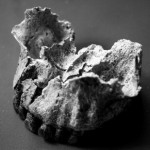 |
OH 65 |
3780 |
|
82 - 64 |
MAX
, TOOTH |
1995 |
127 - National Natural History Museum, Arusha, Tanzania |
I |
Middle/Upper |
|
Blumenschine, R. J., Peters, C. R., Masao, F. T., et al. 2003. Late Pliocene Homo and Hominid Land Use from Western Olduvai Gorge, Tanzania. Science 299, 1217-1221. |
Author describes specimen as "complete maxilla with all teeth and lower face of adult".�Specimen is pictured in images 1-11. (Images from R. Clarke 2011). |
|
|
|
Yes |
|
Mammalia |
Primates |
Anthropoidea |
Haplorhini |
Hominoidea |
Hominidae |
Homininae |
Hominini |
Homo |
habilis |
|
Large habilis |
No |
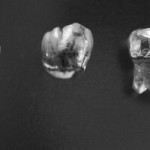 |
OH 69 |
3784 |
80 - MCK |
|
L-P |
2002 |
127 - National Natural History Museum, Arusha, Tanzania |
II |
Lower |
|
|
Lower P4.�Specimen is pictured on left in image 1.�Specimen is pictured on left in image 2. |
|
|
|
Yes |
|
Mammalia |
Primates |
Anthropoidea |
Haplorhini |
Hominoidea |
Hominidae |
Homininae |
Hominini |
Homo |
habilis |
sunsu lato |
|
No |
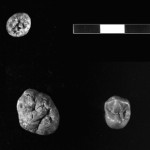 |
OH 73 |
3788 |
81 - HWK W |
|
L-P |
2006 |
127 - National Natural History Museum, Arusha, Tanzania |
I |
Upper |
Surface. |
Clarke, R.J. Published online 4 May 2012. A Homo habilis maxilla and other newly-discovered hominid fossils from Olduvai Gorge, Tanzania.� Olduvai Special issue, JHE |
Left P3.�Specimen is pictured third from the left bottom in image 1.�Specimen is shown on left in image 2. |
|
|
|
No |
|
Mammalia |
Primates |
Anthropoidea |
Haplorhini |
Hominoidea |
Hominidae |
Homininae |
Hominini |
Homo |
habilis |
sensu stricto |
|
No |
 |
OH 4 |
3720 |
8 - MK |
281 - 11 |
P
, M
, MAN |
1959 |
122 - National Museum and House of Culture, Dar es Salaam, Tanzania |
I |
Lower |
Surface. |
Leakey, L.S.B., Tobias, P.V. & Napier, J.R. 1964. A new species of the genus Homo from Olduvai Gorge. Nature 202(4927): 7-9. |
Paratype. Two isolated teeth (lower molar and upper premolar) and one M3 in a mandible. Found in small block of consolidated tuff. �Specimen previously housed at National Museum of Kenya. |
282 - H. Mukiri |
|
264 - Leakey family expedition |
Yes |
|
Mammalia |
Primates |
Anthropoidea |
Haplorhini |
Hominoidea |
Hominidae |
Homininae |
Hominini |
Homo |
habilis |
|
Paratype |
No |
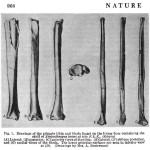 |
OH 6 |
3721 |
5 - FLK |
283 - 45 |
CRA-f
, M-f
, L-P
, L-TIB-f
, L-FIB-f
, |
1959/60 |
122 - National Museum and House of Culture, Dar es Salaam, Tanzania |
I |
Middle (Zinj.) |
Surface. Cranial and dental fragments found in surface soil from slope immediately below Zinj. site; assumed to be from Zinj. level (Leakey, MD, 1971:227). TIB-f and FIB-f from Zinj. level. |
Davis, P. R. 1964. Hominid fossils from Bed I, Olduvai Gorge, Tanganyika. A tibia and fibula. Nature. 201, 967. |
From Tobias (1991): OH 35 tibia and fibula attributed to same individual as OH 6 but appear to be more mature. It is unclear if OH 35 tibia and fibula are the same tibia and fibula originally listed under OH 6. Leakey, MD, 1971 describes CRA and dental fragments as having been found in surface soil, but Leakey, Tobias, and Napier, 1964 state "some [were] found in situ [and] some on the surface" (:9). Unworn lower L-P3. Partially developed roots of upper M1 or 2. Six cranial vault fragments. Tibia and fibula fragments first assumed to be associated with Zinjanthropus OH5, but should be considered associates with OH 6 following morphological study (Leakey, MD, 1971:227). and skull fragments. Juvenile. Specimen previously housed at National Museum of Kenya. |
|
|
264 - Leakey family expedition |
Unknown |
|
Mammalia |
Primates |
Anthropoidea |
Haplorhini |
Hominoidea |
Hominidae |
Homininae |
Hominini |
Homo |
habilis |
|
Paratype. TIB-f and FIB-f not given taxonomic designation in original publication (Davis, 1964) but named as a paratype in Leakey, Tobias, and Napier, 1964. |
No |
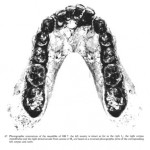 |
OH 7 |
3722 |
6 - FLK NN |
283 - 45 |
MAN
, L-PAR
, R-PAR-f
, M
, OCC-f
, L/R-TEM-f
, PHX
, CAR |
1960 |
122 - National Museum and House of Culture, Dar es Salaam, Tanzania |
I |
3 |
On surface of clay immediately overlying Tuff IB. |
Leakey, L.S.B., Tobias, P.V. & Napier, J.R. 1964. A new species of the genus Homo from Olduvai Gorge. Nature 202(4927): 7-9. |
Holotype. "Jonny's Child". Juvenile. Mandible with partial dentition and unerupted R/L-M3, almost complete left parietal and fragments of right parietal, left and right petrous portions (temporal) , "sundry small skull fragments ... [and] twenty-one bones of the hand, including the trapezium, scaphoid and a number of phalanges" (Leakey, MD, 1971:228). "One upper molar, a terminal phalanx, and a broken capitate bone, found on the surface, probably also belong to this individual" (:226). Specimen previously housed at National Museum of Kenya. |
|
|
264 - Leakey family expedition |
Yes |
|
Mammalia |
Primates |
Anthropoidea |
Haplorhini |
Hominoidea |
Hominidae |
Homininae |
Hominini |
Homo |
habilis |
|
Holotype |
No |
 |
OH 8 |
3723 |
6 - FLK NN |
283 - 45 |
PHX
, CAR
, TAR
, CLA
, AST
, CAL
, CUNE
, CUB
, NAV
, M-f |
1960 |
122 - National Museum and House of Culture, Dar es Salaam, Tanzania |
I |
3 |
|
Leakey MD. (1971) Olduvai Gorge, Vol. 3: excavations in Beds I & II 1960-1963. New York, NY: Cambridge University Press. |
The molar-f was found on the surface and "probably also belongs to OH 8" (Leakey MD, 1971:228). Twelve associated foot bones including astragalus (has carnivore tooth marks (Leakey MD, 1971), calcaneus, cuboid and navicular, cuneiforms 1- 3, proximal ends with shafts, five metatarsals. Proximal ends of one metacarpal and three finger phalanges. One radius shaft. Clavicle with damaged articular ends. Foot articulates "almost perfectly with the OH 35 leg" (Susman, 1983:372). |
130 - L.S.B. Leakey |
|
264 - Leakey family expedition |
Yes |
|
Mammalia |
Primates |
Anthropoidea |
Haplorhini |
Hominoidea |
Hominidae |
Homininae |
Hominini |
Homo |
habilis |
|
Paratype |
No |
 |
OH 13 |
3728 |
27 - MNK |
287 - 88 "Skull Site" |
MAN
, MAX
, CRA-f |
1963 |
122 - National Museum and House of Culture, Dar es Salaam, Tanzania |
II |
Lower Middle IIB |
5 feet above chert horizon |
|
Paratpye. "This consists of a sub-adult skull, probably female, with the third molars coming into wear. It is represented by the greater part of the mandible, including the complete dentition, although the crowns of the incisors are damaged and the left ascending ram us is not preserved; the greater part of the maxillae, represented by two fragments both lacking the anterior portions; the greater part of the occipital; the right parietal and temporal; parts of the left parietal and temporal; together with a few frontal fragments and approximately fifty additional pieces which it has not been possible to fit together" (Leakey MD, 1971:231). Specimen previously housed at National Museum of Kenya. 5 pieces found at House of Culture, Dar es Salaam, Tanzania. |
130 - L.S.B. Leakey |
|
264 - Leakey family expedition |
Yes |
|
Mammalia |
Primates |
Anthropoidea |
Haplorhini |
Hominoidea |
Hominidae |
Homininae |
Hominini |
Homo |
habilis |
|
Paratype |
No |
 |
OH 16 |
3731 |
72 - FLK Maiko Gully |
283 - 45 |
CRA-f
, TOOTH
, MAN
, |
1963 |
122 - National Museum and House of Culture, Dar es Salaam, Tanzania |
II |
base |
| Leakey MD. (1971) Olduvai Gorge, Vol. 3: excavations in Beds I & II 1960-1963. New York, NY: Cambridge University Press. |
Upper and lower dentition, calotte, and > 1500 unidentified fragments due to cattle trampling. Majority of fragments found on surface of Tuff IF, some teeth found in situ, 2 feet above Tuff IF. Specimen previously housed at National Museum of Kenya. |
154 - Leakey and Leakey |
|
264 - Leakey family expedition |
No |
|
Mammalia |
Primates |
Anthropoidea |
Haplorhini |
Hominoidea |
Hominidae |
Homininae |
Hominini |
Homo |
habilis |
|
Leakey LSB, 1964 refers to this specimen as Homo erectus. Leakey, Tobias, and Napier provisionally assign it to Homo habilis (referred material, not paratype) (1964), and Leakey MD, 1971 refers to it as cf. Australopithecus. |
Yes |
|
OH 17 |
3732 |
72 - FLK Maiko Gully |
|
d-M |
1963 |
122 - National Museum and House of Culture, Dar es Salaam, Tanzania |
II |
Surface |
Stream bed of Maiko Gully |
Leakey MD. (1971) Olduvai Gorge, Vol. 3: excavations in Beds I & II 1960-1963. New York, NY: Cambridge University Press. |
Specimen previously housed at National Museum of Kenya. |
142 - M. D. Leakey |
|
264 - Leakey family expedition |
No |
|
Mammalia |
Primates |
Anthropoidea |
Haplorhini |
Hominoidea |
Hominidae |
Homininae |
Hominini |
Homo |
habilis |
|
|
No |
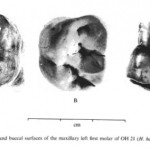 |
OH 21 |
3736 |
7 - FLK North |
|
L-M |
1968 |
122 - National Museum and House of Culture, Dar es Salaam, Tanzania |
I |
Upper |
Surface |
Leakey MD. (1971) Olduvai Gorge, Vol. 3: excavations in Beds I & II 1960-1963. New York, NY: Cambridge University Press. |
Upper left M1, small and unworn. Specimen previously housed at National Museum of Kenya. |
142 - M. D. Leakey |
|
264 - Leakey family expedition |
No |
|
Mammalia |
Primates |
Anthropoidea |
Haplorhini |
Hominoidea |
Hominidae |
Homininae |
Hominini |
Homo |
habilis |
|
|
No |
|
OH 24 |
3739 |
74 - DK E |
|
CRA
, M
, P |
1968 |
122 - National Museum and House of Culture, Dar es Salaam, Tanzania |
I |
Lower |
Surface |
Tobias, PV. 1991. The Skulls, endocasts and teeth of Homo habilis. Cambridge: University Press. |
Cranium is crushed. Teeth not specified. From same horizon as OH 4. Specimen previously housed at National Museum of Kenya. |
142 - M. D. Leakey |
|
264 - Leakey family expedition |
No |
|
Mammalia |
Primates |
Anthropoidea |
Haplorhini |
Hominoidea |
Hominidae |
Homininae |
Hominini |
Homo |
habilis |
|
|
No |
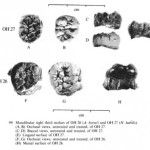 |
OH 27 |
3742 |
37 - HWK EE |
|
R-M |
1969 |
122 - National Museum and House of Culture, Dar es Salaam, Tanzania |
I |
3 meters below Tuff IF |
Surface. |
Tobias, PV. 1991. The Skulls, endocasts and teeth of Homo habilis. Cambridge: University Press. |
Lower M3, unworn. "It is not possible to indicate more than broadly the original position of this tooth, since the clays above and below Tuff IF, as well as the Sandy Conglomerate, are all fossiliferous in this areaand yield mammalian teeth in a similar state of preservation to the hominid molar...the tooth was derived from either Upper Bed I or Lower Bed II" (Tobias, 1991:849). Specimen previously housed at National Museum of Kenya. |
|
|
264 - Leakey family expedition |
No |
|
Mammalia |
Primates |
Anthropoidea |
Haplorhini |
Hominoidea |
Hominidae |
Homininae |
Hominini |
Homo |
habilis |
|
|
No |
|
OH 35 |
3750 |
6 - FLK NN |
|
TIB
, FIB |
1960 |
122 - National Museum and House of Culture, Dar es Salaam, Tanzania |
I |
22 |
|
Davis, P. R. 1964. Hominid fossils from Bed I, Olduvai Gorge, Tanganyika. A tibia and fibula. Nature. 201, 967. |
Almost complete. Attributed to same individual as skull fragments and teeth of OH 6 but appear to be more mature (Tobias, 1991). Specimen previously housed at National Museum of Kenya. |
|
|
264 - Leakey family expedition |
Yes |
|
Mammalia |
Primates |
Anthropoidea |
Haplorhini |
Hominoidea |
Hominidae |
Homininae |
Hominini |
Homo |
habilis |
|
|
No |
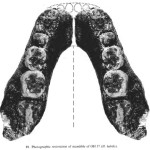 |
OH 37 |
3752 |
5 - FLK |
|
L-MAN
, M
, M |
1971 |
122 - National Museum and House of Culture, Dar es Salaam, Tanzania |
II |
Middle |
Surface, probably from sandy conglomerate in Middle Bed II. |
Leakey, M.D. 1978. Olduvai fossil hominids:their stratigraphic positions and associations. In: Jolly, CJ, editor. Early hominids of Africa. London:Duckworth. P. 3-16. |
Left half mandible with M1-M2. Specimen previously housed at National Museum of Kenya. |
142 - M. D. Leakey |
|
264 - Leakey family expedition |
No |
|
Mammalia |
Primates |
Anthropoidea |
Haplorhini |
Hominoidea |
Hominidae |
Homininae |
Hominini |
Homo |
habilis |
|
|
No |
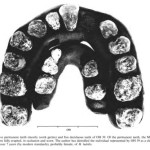 |
OH 39 |
3754 |
37 - HWK EE |
|
TOOTH
, d-TOOTH |
1972 |
122 - National Museum and House of Culture, Dar es Salaam, Tanzania |
I |
Upper |
In fallen block from Upper Bed I. Surface. |
Leakey, M.D. 1978. Olduvai fossil hominids:their stratigraphic positions and associations. In: Jolly, CJ, editor. Early hominids of Africa. London:Duckworth. P. 3-16. |
Upper dentitions: Partial permanent and deciduous dentition. Specimen previously housed at National Museum of Kenya. |
142 - M. D. Leakey |
|
264 - Leakey family expedition |
Unknown |
|
Mammalia |
Primates |
Anthropoidea |
Haplorhini |
Hominoidea |
Hominidae |
Homininae |
Hominini |
Homo |
habilis |
|
|
No |
|
OH 41 |
3756 |
37 - HWK EE |
|
L-M |
1972 |
122 - National Museum and House of Culture, Dar es Salaam, Tanzania |
II |
Lower |
|
Leakey, M.D. 1978. Olduvai fossil hominids:their stratigraphic positions and associations. In: Jolly, CJ, editor. Early hominids of Africa. London:Duckworth. P. 3-16. |
Upper M1 or M2. Specimen previously housed at National Museum of Kenya. |
142 - M. D. Leakey |
|
264 - Leakey family expedition |
Yes |
|
Mammalia |
Primates |
Anthropoidea |
Haplorhini |
Hominoidea |
Hominidae |
Homininae |
Hominini |
Homo |
habilis |
|
|
No |
 |
10 736 |
10180 |
7 - FLK North |
|
R-COR |
|
|
I |
Upper |
|
Brodkorb P., Mourer-Chauviré C. 1982. Fossil Anhingas (Aves: Anhingidae) from early man sites of Hadar and Omo (Ethiopia) and Olduvai Gorge (Tanzania). Geobios 15: 505-515 |
Right coracoid, almost complete expect for sternocoracoidal process and tip of procoracoid process. "Place of conservation of material : The fossils are currently on deposit at the University of Florida, Department of Zoology, and will later be returned to their countries of origin. The serial numbers such as 2780 are catalogue numbers of the Olduvai birds, and the data are kept at the University of Florida, Gainesville" (Brodkorb and Mourer-Chauvire, 1982:510). Specimen number does not match specimen pictured. It is possibly that there is a typo that erroneously listed the specimen pictured in figures 5 and 6. Figure description: "Right coracoid, 10 737, Lower Pleistocene, Frida Leakey Horongo, Olduvai Gorge, Tanzania. (5) anterior view. (6) posterior view" (Brodkorb and Mourer-Chauvire, 1982). |
|
|
264 - Leakey family expedition |
Unknown |
|
Aves |
Suliformes |
|
|
|
Anhingidae |
|
|
Anhinga |
hadarensis |
|
|
No |
 |
2870 |
10181 |
6 - FLK NN |
|
R-COR-f |
|
|
I |
Lower |
Layer 4 |
Brodkorb P., Mourer-Chauviré C. 1982. Fossil Anhingas (Aves: Anhingidae) from early man sites of Hadar and Omo (Ethiopia) and Olduvai Gorge (Tanzania). Geobios 15: 505-515 |
Upper half of right coracoid lacking head. "Place of conservation of material : The fossils are currently on deposit at the University of Florida, Department of Zoology, and will later be returned to their countries of origin. The serial numbers such as 2780 are catalogue numbers of the Olduvai birds, and the data are kept at the University of Florida, Gainesville" (Brodkorb and Mourer-Chauvire, 1982:510). Specimen number does not match specimen pictured. It is possible that there is a typo that erroneously lists the specimen pictured in figures 5 and 6. Figure description: "Upper half of right coracoid, 2870, Lower Pleistocene, Frida Leakey Korongo, Olduvai Gorge, Tanzania, posterior view." (Brodkorb and Mourer-Chauvire, 1982). |
|
|
264 - Leakey family expedition |
Unknown |
|
Aves |
Suliformes |
|
|
|
Anhingidae |
|
|
Anhinga |
hadarensis |
|
|
No |
 |
11 234 |
10182 |
58 - KK |
|
L-ULNA-f |
|
|
II |
"Probably lower middle" (Brodkorb and Mourer-Chauvire, 1982:510). |
|
Brodkorb P., Mourer-Chauviré C. 1982. Fossil Anhingas (Aves: Anhingidae) from early man sites of Hadar and Omo (Ethiopia) and Olduvai Gorge (Tanzania). Geobios 15: 505-515 |
Distal half of left ulna. "Place of conservation of material : The fossils are currently on deposit at the University of Florida, Department of Zoology, and will later be returned to their countries of origin. The serial numbers such as 2780 are catalogue numbers of the Olduvai birds, and the data are kept at the University of Florida, Gainesville" (Brodkorb and Mourer-Chauvire, 1982:510). Figure description: "Fig. 14 - 15 -- Distal half of left ulna, 11 234, Lower Pleistocene, Kudu Korongo, Olduvai Gorge, Tanzania. (14) internal view. (15) external view." (Brodkorb and Mourer-Chauvire, 1982). |
|
|
264 - Leakey family expedition |
Unknown |
|
Aves |
Suliformes |
|
|
|
Anhingidae |
|
|
Anhinga |
hadarensis |
|
|
No |
|
M18783 |
7635 |
9 - THC |
|
CAR |
|
|
I |
|
|
-- |
All specimens for this paper are thought to be from one individual (MNI = 1). �Each specimen has its own specimen number. �This carpal is a lunate. |
|
|
|
Unknown |
|
Mammalia |
Perissodactyla |
Ceratomorpha |
Selenida |
Chalicotherioidea |
Chalicotheriidae |
Schizotheriinae |
Schizotheriini |
Ancylotherium |
hennigi |
|
|
No |
|
M18785 |
7636 |
9 - THC |
|
CAR |
|
|
I |
|
|
|
All specimens for this paper are thought to be from one individual (MNI = 1). �Each specimen has its own specimen number. �This carpal is a scaphoid. |
|
|
|
Unknown |
|
Mammalia |
Perissodactyla |
Ceratomorpha |
Selenida |
Chalicotherioidea |
Chalicotheriidae |
Schizotheriinae |
Schizotheriini |
Ancylotherium |
hennigi |
|
Shows resemblance to A. pentelicum. |
No |
|
M18784 |
7637 |
9 - THC |
|
CAR |
|
|
I |
|
|
|
All specimens for this paper are thought to be from one individual (MNI = 1). �Each specimen has its own specimen number. �This carpal is a cuneiform. |
|
|
|
Unknown |
|
Mammalia |
Perissodactyla |
Ceratomorpha |
Selenida |
Chalicotherioidea |
Chalicotheriidae |
Schizotheriinae |
Schizotheriini |
Ancylotherium |
hennigi |
|
|
No |
|
M18786 |
7638 |
9 - THC |
|
MTC |
|
|
I |
|
|
|
All specimens for this paper are thought to be from one individual (MNI = 1). �Each specimen has its own specimen number. �This is the second metacarpal. |
|
|
|
Unknown |
|
Mammalia |
Perissodactyla |
Ceratomorpha |
Selenida |
Chalicotherioidea |
Chalicotheriidae |
Schizotheriinae |
Schizotheriini |
Ancylotherium |
hennigi |
|
|
No |
|
M18782 |
7639 |
9 - THC |
|
MTC |
|
|
I |
|
|
|
All specimens for this paper are thought to be from one individual (MNI = 1). �Each specimen has its own specimen number. �This is the third metacarpal. |
|
|
|
Unknown |
|
Mammalia |
Perissodactyla |
Ceratomorpha |
Selenida |
Chalicotherioidea |
Chalicotheriidae |
Schizotheriinae |
Schizotheriini |
Ancylotherium |
hennigi |
|
|
No |
|
M18780 |
7640 |
9 - THC |
|
PHX |
|
|
I |
|
|
|
All specimens for this paper are thought to be from one individual (MNI = 1). �Each specimen has its own specimen number. �This is the proximal phalanx. |
|
|
|
Unknown |
|
Mammalia |
Perissodactyla |
Ceratomorpha |
Selenida |
Chalicotherioidea |
Chalicotheriidae |
Schizotheriinae |
Schizotheriini |
Ancylotherium |
hennigi |
|
|
No |
|
M18781 |
7641 |
9 - THC |
|
PHX, (n=2) |
|
|
I |
|
|
|
All specimens for this paper are thought to be from one individual (MNI = 1). �Each specimen has its own specimen number. �These are two middle phalanges. |
|
|
|
Unknown |
|
Mammalia |
Perissodactyla |
Ceratomorpha |
Selenida |
Chalicotherioidea |
Chalicotheriidae |
Schizotheriinae |
Schizotheriini |
Ancylotherium |
hennigi |
|
|
No |
|
M18783 |
3874 |
9 - THC |
|
CAR |
|
|
I |
|
|
-- |
All specimens for this paper are thought to be from one individual (MNI = 1). �Each specimen has its own specimen number. �This carpal is a lunate. |
|
|
|
Unknown |
|
Mammalia |
Perissodactyla |
Ceratomorpha |
Selenida |
Chalicotherioidea |
Chalicotheriidae |
Schizotheriinae |
Schizotheriini |
Ancylotherium |
hennigi |
|
|
No |
|
M18785 |
3875 |
9 - THC |
|
CAR |
|
|
I |
|
|
|
All specimens for this paper are thought to be from one individual (MNI = 1). �Each specimen has its own specimen number. �This carpal is a scaphoid. |
|
|
|
Unknown |
|
Mammalia |
Perissodactyla |
Ceratomorpha |
Selenida |
Chalicotherioidea |
Chalicotheriidae |
Schizotheriinae |
Schizotheriini |
Ancylotherium |
hennigi |
|
Shows resemblance to A. pentelicum. |
No |
|
M18784 |
3876 |
9 - THC |
|
CAR |
|
|
I |
|
|
Butler, P. M., 1965. Fossil Mammals of Africa No. 18. East African Miocene and Pleistocene Chalicotheres. Bulletin of the British Museum (Natural History) (Geology), 10: 163-23. |
All specimens for this paper are thought to be from one individual (MNI = 1). �Each specimen has its own specimen number. �This carpal is a cuneiform. |
|
|
|
Unknown |
|
Mammalia |
Perissodactyla |
Ceratomorpha |
Selenida |
Chalicotherioidea |
Chalicotheriidae |
Schizotheriinae |
Schizotheriini |
Ancylotherium |
hennigi |
|
|
No |
|
M18786 |
3877 |
9 - THC |
|
MTC |
|
|
I |
|
|
|
All specimens for this paper are thought to be from one individual (MNI = 1). �Each specimen has its own specimen number. �This is the second metacarpal. |
|
|
|
Unknown |
|
Mammalia |
Perissodactyla |
Ceratomorpha |
Selenida |
Chalicotherioidea |
Chalicotheriidae |
Schizotheriinae |
Schizotheriini |
Ancylotherium |
hennigi |
|
|
No |
|
M18782 |
3878 |
9 - THC |
|
MTC |
|
|
I |
|
|
|
All specimens for this paper are thought to be from one individual (MNI = 1). �Each specimen has its own specimen number. �This is the third metacarpal. |
|
|
|
Unknown |
|
Mammalia |
Perissodactyla |
Ceratomorpha |
Selenida |
Chalicotherioidea |
Chalicotheriidae |
Schizotheriinae |
Schizotheriini |
Ancylotherium |
hennigi |
|
|
No |
|
M18780 |
3879 |
9 - THC |
|
PHX |
|
|
I |
|
|
|
All specimens for this paper are thought to be from one individual (MNI = 1). �Each specimen has its own specimen number. �This is the proximal phalanx. |
|
|
|
Unknown |
|
Mammalia |
Perissodactyla |
Ceratomorpha |
Selenida |
Chalicotherioidea |
Chalicotheriidae |
Schizotheriinae |
Schizotheriini |
Ancylotherium |
hennigi |
|
|
No |
|
M18781 |
3880 |
9 - THC |
|
PHX, (n=2) |
|
|
I |
|
|
|
All specimens for this paper are thought to be from one individual (MNI = 1). �Each specimen has its own specimen number. �These are two middle phalanges. |
|
|
|
Unknown |
|
Mammalia |
Perissodactyla |
Ceratomorpha |
Selenida |
Chalicotherioidea |
Chalicotheriidae |
Schizotheriinae |
Schizotheriini |
Ancylotherium |
hennigi |
|
|
No |
|
OVPP-Ancylotherium 1 |
98 |
9 - THC |
|
FPX |
|
104 - Unknown |
I |
|
|
Leakey LSB. 1965. Olduvai Gorge 1951-1961, Volume 1: Fauna and Background. New York, NY: Cambridge University Press. |
Several foot bones are indicated but not described. |
136 - P. M. Butler |
|
264 - Leakey family expedition |
Unknown |
|
Mammalia |
Perissodactyla |
Ceratomorpha |
Selenida |
Chalicotherioidea |
Chalicotheriidae |
Schizotheriinae |
Schizotheriini |
Ancylotherium |
hennigi |
|
|
No |
|
OVPP-P-52 |
13334 |
|
|
L. MAN-f |
|
|
|
|
|
-- |
OLD I 1960 NN II-3 FLKI 753(or 763?). Cast |
|
|
|
Unknown |
|
|
Carnivora |
|
|
|
Herpestidae |
|
|
|
Herpestes primitivus |
|
|
Yes |
|
OVPP-P-53 |
13335 |
|
|
R. MAN-f |
|
|
|
|
|
-- |
OLD I 1960 NNI FLK 764. Cast |
|
|
|
Unknown |
|
|
Carnivora |
|
|
|
Herpestidae |
|
|
|
Herpestes primitivus |
|
|
Yes |
|
OVPP-Mesochoerus 1 |
252 |
23 - TK |
|
M |
|
104 - Unknown |
II |
|
Lower layers |
Leakey LSB. 1965. Olduvai Gorge 1951-1961, Volume 1: Fauna and Background. New York, NY: Cambridge University Press. |
|
|
|
264 - Leakey family expedition |
Unknown |
|
Mammalia |
Artiodactyla |
Suiformes |
|
Suoidea |
Suidae |
Suinae |
Suini |
Mesochoerus |
heseloni |
|
|
No |
|
OVPP-Crocidura 1 |
8 |
6 - FLK NN |
|
UK |
|
104 - Unknown |
I |
middle |
1, 3 |
Leakey LSB. 1965. Olduvai Gorge 1951-1961, Volume 1: Fauna and Background. New York, NY: Cambridge University Press. |
Ten specimens found in FLK NN I. |
130 - L.S.B. Leakey |
|
264 - Leakey family expedition |
Yes |
|
Mammalia |
Insectivora |
|
|
Soricoidea |
Soricidae |
Crocidurinae |
|
Crocidura |
hindei |
|
|
No |
|
OVPP-Crocidura 2 |
9 |
7 - FLK North |
|
UK |
|
104 - Unknown |
I |
upper |
3, 4, 5 |
Leakey LSB. 1965. Olduvai Gorge 1951-1961, Volume 1: Fauna and Background. New York, NY: Cambridge University Press. |
A few specimens found in layers 3, 4, and 5. |
130 - L.S.B. Leakey |
|
264 - Leakey family expedition |
Yes |
|
Mammalia |
Insectivora |
|
|
Soricoidea |
Soricidae |
Crocidurinae |
|
Crocidura |
hindei |
|
|
No |















